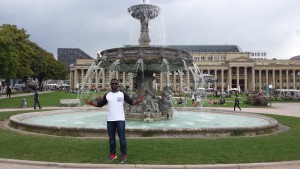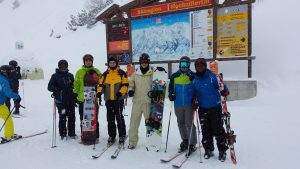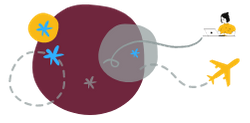Updated: 18 May 2016
Brian is currently at the University of Stuttgart; here are his experiences and first impresssions.
Pre-departure:
When I signed up for PhD studies, the intention was always to do part of my research work abroad/overseas, in order to get some international exposure, and also make new contacts in my chosen field of research. My supervisors were already in contact with a professor at the University of Stuttgart, who has expertise in a component of my research work, and was willing to supervise my work whilst I was in Stuttgart. This therefore influenced my choice of university for exchange, and the fact that the University of Stuttgart already had a partnership with Stellenbosch University made the exchange possible.
The application process was smooth and within a week or so, I was informed of my successful application by the coordinator for student exchanges and mobility programmes, and the willingness of Stellenbosch University – barring any objection on my part – to nominate me for an exchange program to the University of Stuttgart. Shortly after my nomination, The University of Stuttgart contacted me and forwarded information on how to complete their online application (C@mpus) for the Exchange/Non degree program for the winter 2015/16 semester (1st October, 2015 to 31st March, 2016). The Studierendenwerk Stuttgart also contacted me and provided information on how to apply for a student dorm. Exchange students are given first priority to the student dorms on campus. At this stage, the application process was just a formality, and therefore I could now buy an air ticket and also apply for a study/long stay visa to Germany.
The study visa application process is straight forward and all the necessary information is posted on the website of the German Embassy/Consulate in South Africa. A checklist is also provided, to be completed, before booking and showing up for the interview at the Consulate in Cape Town. I was issued with a 3 month visa, within two days of applying. This was converted to a residence permit, for the duration of the exchange, a few days after arriving in Stuttgart.
The duration of exchange is normally tagged to the duration of one’s German health insurance cover. The main documents required for the visa application are: an admission/invitation letter from the exchange University, proof of scholarship/sufficient funds, original police clearance certificate from the South African Police Services (SAPS) and German health insurance cover for the duration of one’s stay in Germany. The police clearance certificate was the only document that had the potential of delaying my application. I therefore immediately applied for it at the SAPS offices in Stellenbosch. The International Affairs (IZ) office of the University of Stuttgart also wrote me an invitation letter. In this letter, they requested the German Consulate to forfeit the 50 Euro visa fee I was meant to pay, which saved me a bit of money.
I also received a DAAD scholarship for exchange students to the University of Stuttgart, and this was my proof of scholarship. For health insurance cover, I initially took out travel insurance cover with Hollard travel, and on arrival in Stuttgart, I applied for German Health Insurance. Hollard travel insurance cover is free for all Momentum Health members, and information about it is available on the Momentum Health website. The German Health insurance is only applicable for the duration of the semester, and since I arrived a month earlier than the beginning of the semester – so I could attend the German Intensive Course – it was necessary to take out travel insurance cover for that first month.
To get a feel for the cost of flight tickets to Germany, I visited and/or wrote emails to travel agencies like Neelsie Travel, Student Flights and Maties Travel. Information on the cost of flight tickets can also be found on their Websites. I also regularly visited travel websites like TripAdvisor and different airlines websites, for information on how to plan my travel itinerary and to find the cheapest flights available. The critical factors I considered were the cost, the departure and arrival times, and the number and duration of the stopovers. I also took into consideration that on arrival in Stuttgart, I could only check into the student dorm during the office hours of the House Master (Hausmeister). Also, before I could depart from Stuttgart, I had to allow for enough time for inspection of my room by the Hausmeister, if my rent deposit were to be paid back in cash.
I eventually bought a relatively cheap return flight ticket off the Emirates airlines website. I flew from Cape Town to Frankfurt, with a two hour stop in Dubai. For the connection from Frankfurt to Stuttgart, I bought a cheap Deutsche Bahn (DB) one way train ticket off the DB Bahn website. A one way ticket purchased at the train station costs more than 3 times the cost of the online ticket. I allowed for at least 2 hours between the landing of my flight and taking the connecting train, in case of a delay in reclaiming my baggage or clearing with immigration. It’s important to note that I bought both the flight and train tickets using my regular Standard Bank cheque card, something I previously thought was only possible using a credit card.
After receiving my study visa, and buying my flight and train tickets, I was now set for Germany. The countdown could now begin…
Experience:
My flight to Germany was hassle free and I landed at Frankfurt airport a few minutes after 8am, on 1st September, 2015, having departed from Cape Town at 1:30pm, on 31st August, 2015. After inquiring about how to get to the Frankfurt Main Train Station (Hauptbahnof), at one of the Information desks at the airport, I made my way to an airport shuttle that took me from the airport to the Frankfurt Hauptbahnof. At the Hauptbahnof, all the information about the different trains’ arrival and departure times, and their destinations is provided on the notice boards. It’s important to have with you a hard copy of the online train ticket, as the train controllers are very fussy about this.
The first week in Stuttgart was spent attending information sessions at the IZ; mainly about how to live in Stuttgart, apply for German health Insurance, open up a German bank account (Girokonto) and apply for a residence permit at the Residents’ Registration Office (Bürgerbüro). In this same period, I also registered for the German Intensive Course and an IZ organised excursion to the Black Forest. For the rest of September to early October, I spent the mornings and early afternoons attending the 6 hour/5 days a week German Intensive course. Most of the late afternoons during this period were spent discovering the Stuttgart City Centre (Stadtmitte).

Although the classes were very long, they were very helpful in getting me to listen to, speak and write German, for everyday situations. These classes were also my first real encounter with most of the other international students. The German Intensive Course participants were separated into early morning to early afternoon and late afternoon to evening classes. This could either work for or against you, depending on whether you are an early riser or not. The course costs 250 Euros, which I personally found very exorbitant. The fact that the first payment of my scholarship was only made in the middle of October, didn’t help either. If one intends to attend the German Intensive Course, it is important that she or he has enough funds for atleast the first 1 and half months in Stuttgart.
During September, I attended an IZ organised excursion to the very beautiful town of Baden Baden, situated between the Rhine Valley and the foothills of the Northern Black Forest. The excursion included a guided tour through this old famous Spa Town, its beautiful parks and its fascinating old Casino. The last stop of the excursion was Lake Mummelsee, located at a height of 1036 metres above sea level. Here, the excursion group enjoyed a demonstration of how the famous Black Forest Cake is made, and later tasted this delicious cake over a cup of tea or coffee.
One of the highlights of my stay in Germany so far was attending the Munich Oktoberfest, and to a lesser extent the Stuttgart Cannstatter Volksfest. These are two of the largest and most famous beer festivals in the world and they run from late September to early October, with the former starting and ending a few days earlier than the latter. I always wanted to attend the Oktoberfest, and coming to Germany during the Winter Semester meant this was possible. Friends and I bought a discounted group return train ticket to Munich, which saved us a bit of money. Seeing multitudes of people dressed in traditional Bavarian wear (Lederhosen and Dirndl), drinking German beer from giant 1 litre beer glasses (Maβ), dancing on tables and singing on top of their voices made for a unique experience. The occasion was made more special, as I also wore a Lederhosen, which I borrowed from a German friend.
I wrote the German Intensive Course exam on Friday 9th October, 2015, and on Monday 12th October, 2015, I started my research work at the Institute of Thermal Turbomachinery and Machinery laboratory (ITSM). Last week I had the first skype meeting with my Professors back in Stellenbosch, and it was amusing to see the excitement on their faces, on speaking to me after a ‘long’ period with no communication. Am excited about my research work and can’t wait to get stuck in. I am also looking forward to doing a bit of travelling around Europe towards the end of the year. Till next time, Tschüss!
Experience (cont’d):
My work at ITSM entailed designing a combustor for micro gas turbine applications. I shared office space with two fulltime research engineers/part time PhD students. At most research institutes/universities in Germany, the norm is to employ, on contract basis, fulltime research engineers, who also partake in part time PhD studies. The research engineers at ITSM mainly work on projects from major turbomachinery companies like Siemens and Alstom, and this gives them relevant industry experience/skills and also puts them into contact with potential future employers. The only downside to the full time research engineer/part time PhD student arrangement is that the PhD degrees take longer to complete (on average 6 years), and renewal of one’s contract is not guaranteed for the duration of the PhD. The research engineers also directly supervise Bachelor and Masters’ students, and also assist in lecturing. To follow my progress, I had weekly meetings with my professor at ITSM, while my professors back in Stellenbosch joined us for bi-weekly skype meetings.
During the course of the winter semester, I also attended the Extensive German Course. This was a continuation of the Intensive German Course, but was spread out over the whole semester, with classes every Monday afternoon, from 13:30 to 17:00hrs. It was easier to follow these classes, given the knowledge I picked up during the Intensive German Course. Being around and interacting on a daily basis with German speaking people at ITSM also helped.
During the first part of the semester, I visited a close friend in Hamburg, whom I met during her semester exchange to Stellenbosch University. Hamburg is a beautiful, cosmopolitan city and I thoroughly enjoyed my stay there. I took a stroll through the famous Reeperbahn and also checked out the red-light district (Herbertstraβe)! Over the Christmas break, I visited a friend and his young family in Barcelona. He met his wife while she was doing her post doc at Stellenbosch University. During my stay in Barcelona, I took a red tour bus around the city, and made a point to stop at the famous Camp Nou, FC Barcelona’s 100,000 seater stadium.
Without a doubt, the biggest highlight of my stay in Europe was a weekend skiing trip to the Austrian Alps, which I took with five of my colleagues from ITSM. We drove from Stuttgart, through Bayern and into Austria, and stayed at a flat owned by the parents of one of my colleagues. The guys on the trip collectively organised skiing gear for me, which saved me some money. I would normally have had to rent this gear from a skiing resort, at a relatively high price. The exhilarating feeling of skiing down a slope at break neck speed, with the snow pounding down on my face is something I will never forget. I would definitely want to go skiing again in the future!
During my last month in Germany, I cancelled my health insurance and de-registered at both the University of Stuttgart and at the Bürgerbüro. I also made my arrangements to close my German bank account and booked an appointment with the Hausmeister, to inspect my room and confirm that it’s in the condition that I found it. Without both closing my account and getting the confirmation from the Hausmeister, I wouldn’t be able to get a cash refund of my rent deposit. During this time I also started the Stellenbosch University registration process for the 2016 academic year.
In my last week in Germany, I visited the famous Mercedes Benz museum. I also visited the factory shops in Metzigen, to try and pick out a bargain or two of branded clothing and shoes, before my return to South Africa.

The skiing trip squad
Return:
I returned to South Africa on 1st march, 2016, exactly six months since my departure. I have to admit, I struggled to settle in for the first few weeks, and I found myself easily distracted. This was worsened by the fact that I had failed to secure accommodation in Stellenbosch before my return. Since the semester was already a month old, most of the accommodation in Stellenbosch was already taken up. I organised to crash at a friend’s place and spent the better part of my first days here viewing the flats that were still available. After failing to find a flat that I liked, I eventually decided to take up accommodation at one of the senior residences on campus.
After finding accommodation, everything seemed to fall in place. I am making good progress with my work now, and my professor at ITSM offered to continue following my progress whilst am back in South Africa. I have monthly skype meetings with both him and my two professors in Stellenbosch, and these meetings are really helpful in the context of my work.
All in all, my targets for the exchange were met; I managed to complete a part of my research project that I would normally have found difficult to accomplish here, and I also got first-hand experience at living and working abroad. In addition, I made useful contacts in my chosen field of research and I also learnt a new foreign language. All this should hold me in good stead in the future, in regard to finding work after my studies.
I am forever grateful to the Postgraduate and International Office (PGIO) of Stellenbosch University, the International Affairs (IZ) Office of the University of Stuttgart and the Institute of Thermal Turbomachinery and Machinery Laboratory (ITSM) for making this exchange possible. Danke schön!

